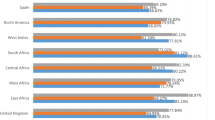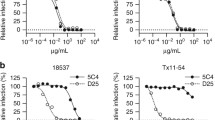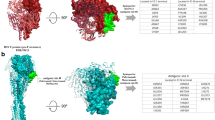Abstract
Human respiratory syncytial virus (RSV) is the leading cause of lower respiratory tract infections in infants and young children. Here, the RSV fusion (F) glycoprotein epitope FFL was redesigned based on its complex crystal structure with motavizumab, an mAb drug in development for the prevention of RSV infections, aiming to obtain therapeutic peptide vaccines with high affinity to induce RSV-specific neutralizing antibodies. Computational modeling and analysis found that only a small region covering the helix-turn-helix (HTH) motif of FFL can directly interact with motavizumab and confer stability and specificity to the complex system, while the rest of the epitope primarily serves as a structural scaffold that stabilizes the HTH conformation of motavizumab-binding site. Molecular dynamics simulations revealed a large flexibility and intrinsic disorder for the isolated linear HTH peptide, which would incur a considerable entropy penalty upon binding to motavizumab. In this respect, the FFL epitope was redesigned by truncation, mutation, and cyclization to derive a number of small cyclic peptide immunogens. We also employed in vitro fluorescence-based assays to demonstrate that the linear epitope peptide has no observable affinity to motavizumab, whereas redesigned versions of the peptide can bind with a moderate or high potency.

Computationally modeled complex structure of RSV F glycoprotein with motavizumab and zoom up of the complex binding site.





Similar content being viewed by others
References
Krilov LR (2011) Respiratory syncytial virus disease: update on treatment and prevention. Expert Rev. Anti-Infect. Ther. 9:27–32
Ogra PL (2004) Respiratory syncytial virus: the virus, the disease and the immune response. Paediatr. Respir. Rev. 5:S119–S126
Lanari M, Vandini S, Arcuri S, Galletti S, Faldella G (2013) The use of humanized monoclonal antibodies for the prevention of respiratory syncytial virus infection. Clin Dev Immunol 2013:359683
Wu H, Pfarr DS, Johnson S, Brewah YA, Woods RM, Patel NK, White WI, Young JF, Kiener PA (2007) Development of motavizumab, an ultra-potent antibody for the prevention of respiratory syncytial virus infection in the upper and lower respiratory tract. J. Mol. Biol. 368:652–665
Mejías A, Ramilo O (2008) Review of palivizumab in the prophylaxis of respiratory syncytial virus (RSV) in high-risk infants. Biologics 2:433–439
Zhu Q, McAuliffe JM, Patel NK, Palmer-Hill FJ, Yang CF, Liang B, Su L, Zhu W, Wachter L, Wilson S, MacGill RS, Krishnan S, McCarthy MP, Losonsky GA, Suzich JA (2011) Analysis of respiratory syncytial virus preclinical and clinical variants resistant to neutralization by monoclonal antibodies palivizumab and/or motavizumab. J. Infect. Dis. 203:674–682
Correia BE, Bates JT, Loomis RJ, Baneyx G, Carrico C, Jardine JG, Rupert P, Correnti C, Kalyuzhniy O, Vittal V, Connell MJ, Stevens E, Schroeter A, Chen M, Macpherson S, Serra AM, Adachi Y, Holmes MA, Li Y, Klevit RE, Graham BS, Wyatt RT, Baker D, Strong RK, Crowe Jr JE, Johnson PR, Schief WR (2014) Proof of principle for epitope-focused vaccine design. Nature 507:201–206
Ni H, Zhuang Y, Chen Z, Ji W (2017) Molecular engineering of respiratory syncytial virus immunogen against pediatric viral pneumonia. Mol. Simul. 44:1–6
McLellan JS, Chen M, Kim A, Yang Y, Graham BS, Kwong PD (2010) Structural basis of respiratory syncytial virus neutralization by motavizumab. Nat. Struct. Mol. Biol. 17:248–250
Word JM, Lovell SC, Richardson JS, Richardson DC (1999) Asparagine and glutamine: using hydrogen atom contacts in the choice of side-chain amide orientation. J. Mol. Biol. 285:1735–1747
Gordon JC, Myers JB, Folta T, Shoja V, Heath LS, Onufriev A (2005) H++: a server for estimating pKa and adding missing hydrogens to macromolecules. Nucleic Acids Res. 33:W368–W371
Case DA, Cheatham 3rd TE, Darden T, Gohlke H, Luo R, Merz Jr KM, Onufriev A, Simmerling C, Wang B, Woods RJ (2005) The amber biomolecular simulation programs. J. Comput. Chem. 26:1668–1688
Duan Y, Wu C, Chowdhury S, Lee MC, Xiong G, Zhang W, Yang R, Cieplak P, Luo R, Lee T, Caldwell J, Wang J, Kollman P (2003) A point-charge force field for molecular mechanics simulations of proteins based on condensed-phase quantum mechanical calculations. J. Comput. Chem. 24:1999–2012
Jorgensen WL, Chandrasekhar J, Madura JD, Impey RW, Klein KL (1983) Comparison of simple potential functions for simulating liquid water. J. Phys. Chem. 79:926–935
Yang C, Zhang S, He P, Wang C, Huang J, Zhou P (2015) Self-binding peptides: folding or binding? J. Chem. Inf. Model. 55:329–342
Yang C, Zhang S, Bai Z, Hou S, Wu D, Huang J, Zhou P (2016) A two-step binding mechanism for the self-binding peptide recognition of target domains. Mol. BioSyst. 12:1201–1213
Ryckaert JP, Ciccotti G, Berendsen HJC (1997) Numerical integration of the cartesian equations of motion of a system with constraints: molecular dynamics of n-alkanes. J. Comput. Phys. 23:327–341
Darden T, York D, Pedersen L (1993) Particle mesh Ewald and n.Log(N) method for Ewald sums in large systems. J. Chem. Phys. 98:10089–10092
Zhou S, Wang Q, Ren M, Zhang A, Liu H, Yao X (2017) Molecular dynamics simulation on the inhibition mechanism of peptide-based inhibitor of islet amyloid polypeptide (IAPP) to islet amyloid polypeptide (IAPP22-28) oligomers. Chem. Biol. Drug Des. 90:31–39
Davidchack RL, Handel R, Tretyakov MV (2009) Langevin thermostat for rigid body dynamics. J. Chem. Phys. 130:234101
Yang C, Wang C, Zhang S, Huang J, Zhou P (2015) Structural and energetic insights into the intermolecular interaction among human leukocyte antigens, clinical hypersensitive drugs and antigenic peptides. Mol. Simul. 41:741–751
Zhou P, Zhang S, Wang Y, Yang C, Huang J (2016) Structural modeling of HLA-B*1502/peptide/carbamazepine/T-cell receptor complex architecture: implication for the molecular mechanism of carbamazepine-induced Stevens-Johnson syndrome/toxic epidermal necrolysis. J. Biomol. Struct. Dyn. 34:1806–1817
Homeyer N, Gohlke H (2012) Free energy calculations by the molecular mechanics Poisson–Boltzmann surface area method. Mol Inf 31:114–122
Tian F, Lv Y, Zhou P, Yang L (2011) Characterization of PDZ domain–peptide interactions using an integrated protocol of QM/MM, PB/SA, and CFEA analyses. J. Comput. Aided Mol. Des. 25:947–958
Bahar I, Lezon TR, Bakan A, Shrivastava IH (2010) Normal mode analysis of biomolecular structures: functional mechanisms of membrane proteins. Chem. Rev. 110:1463–1497
Zhang X, Pickin KA, Bose R, Jura N, Cole PA, Kuriyan J (2007) Inhibition of the EGF receptor by binding of MIG6 to an activating kinase domain interface. Nature 450:741–744
Kaustov L, Ouyang H, Amaya M, Lemak A, Nady N, Duan S, Wasney GA, Li Z, Vedadi M, Schapira M, Min J, Arrowsmith CH (2011) Recognition and specificity determinants of the human cbx chromodomains. J. Biol. Chem. 286:521–529
Schickli JH, Whitacre DC, Tang RS, Kaur J, Lawlor H, Peters CJ, Jones JE, Peterson DL, McCarthy MP, Van Nest G, Milich DR (2015) Palivizumab epitope-displaying virus-like particles protect rodents from RSV challenge. J. Clin. Invest. 125:1637–1647
Zhou P, Tian F, Shang Z (2009) 2D depiction of nonbonding interactions for protein complexes. J. Comput. Chem. 30:940–951
London N, Raveh B, Cohen E, Fathi G, Schueler-Furman O (2011) Rosetta FlexPepDock web server—high resolution modeling of peptide-protein interactions. Nucleic Acids Res. 39:W249–W253
Luo H, Du T, Zhou P, Yang L, Mei H, Ng H, Zhang W, Shu M, Tong W, Shi L, Mendrick DL, Hong H (2015) Molecular docking to identify associations between drugs and class I human leukocyte antigens for predicting idiosyncratic drug reactions. Comb. Chem. High Throughput Screen. 18:296–304
Yu H, Zhou P, Deng M, Shang Z (2014) Indirect readout in protein-peptide recognition: a different story from classical biomolecular recognition. J. Chem. Inf. Model. 54:2022–2032
Patgiri A, Jochim AL, Arora PS (2008) A hydrogen bond surrogate approach for stabilization of short peptide sequences in alpha-helical conformation. Acc. Chem. Res. 41:1289–1300
Walensky LD, Bird GH (2014) Hydrocarbon-stapled peptides: principles, practice, and progress. J. Med. Chem. 57:6275–6288
Bai Z, Hou S, Zhang S, Li Z, Zhou P (2017) Targeting self-binding peptides as a novel strategy to regulate protein activity and function: a case study on the proto-oncogene tyrosine protein kinase c-Src. J. Chem. Inf. Model. 57:835–845
Zhou P, Hou S, Bai Z, Li Z, Wang H, Chen Z, Meng Y (2017) Disrupting the intramolecular interaction between proto-oncogene c-Src SH3 domain and its self-binding peptide PPII with rationally designed peptide ligands. Artif Cells Nanomed Biotechnol. https://doi.org/10.1080/21691401.2017.1360327
Wallace AC, Laskowski RA, Thornton JM (1995) LIGPLOT: a program to generate schematic diagrams of protein-ligand interactions. Protein Eng. 8:127–134
Author information
Authors and Affiliations
Corresponding author
Ethics declarations
Conflict of interest
The authors report no conflicts of interest.
Rights and permissions
About this article
Cite this article
Shi, X., Zheng, J. & Yan, T. Computational redesign of human respiratory syncytial virus epitope as therapeutic peptide vaccines against pediatric pneumonia. J Mol Model 24, 79 (2018). https://doi.org/10.1007/s00894-018-3613-z
Received:
Accepted:
Published:
DOI: https://doi.org/10.1007/s00894-018-3613-z




